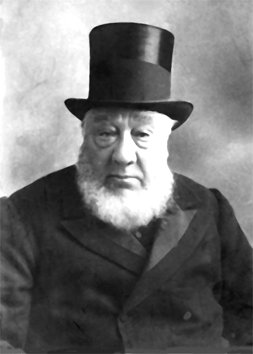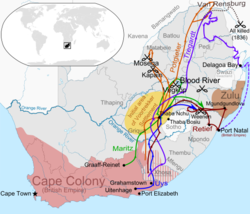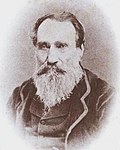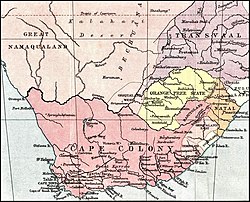Paul Kruger
Stephanus Johannes Paulus Kruger (or just Paul Kruger) (10 October 1825–14 July 1904) was the president of the South African Republic (sometimes incorrectly referred to as the Transvaal) from 1883 to 1900.[1][2][3] He became famous for leading the Boers against the British at the time of the Second Boer War.
Early life
Kruger grew up on his grandfather's farm. He worked as a commando (a soldier defending farms), and became a respected leader.
First Boer War
In 1877 the British Army took control of Transvaal, and Kruger became the leader of the resistance (the people who wanted to fight British control). On 30 December 1880, the government of the South African Republic (Transvaal) elected (chose) him to be president. In 1881 Kruger negotiated (talked with the enemy) to agree the peace. Kruger travelled to Europe, where many people respected him.
Second Boer War
The Second Boer War began in 1899, and Kruger had to escape to Europe in October 1900. He moved to Clarens in Switzerland, where he died in 1904. People took his body back to South Africa and buried him in Church Street Cemetery in Pretoria.
Paul Kruger Media
Great Trek routes of the 1830s and 1840s
Andries Pretorius, a great influence on the young Kruger
Kruger as a field cornet, photographed c. 1852
M W Pretorius, who became the Transvaal's first President in 1857
Stephanus Schoeman, a fierce opponent of Kruger during the 1860s
Kruger, photographed as Commandant-General of the South African Republic, c. 1865. The loss of his left thumb is visible.
President Thomas François Burgers, whose election dismayed Kruger
E. J. P. Jorissen, Kruger's colleague in the first deputation to London, pictured in 1897
References
- ↑ Farwell, Byron Queen Victoria's Little Wars WW Norton and Company New York 1972 page 352
- ↑ Holmes, Prescott Paul Kruger: The Life Story of the President of the Transvaal Henry Altemus Philadelphia 1900 page 99
- ↑ Kruger, Paul The Memoirs of Paul Kruger: Four Times President of the South African Republic Told by Himself The Century Co. New York 1902 pages 167-168









